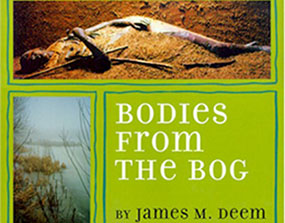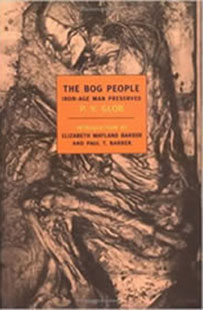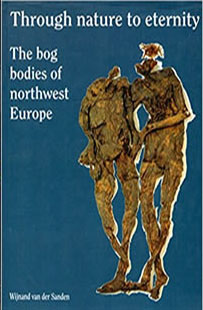Paperback edition, 2003.
|
~~ Suggestions for Visiting Bogs and Bog Bodies ~~ ~~ Bog Body Stories ~~ Related Books by James M Deem: Bodies from the Ice ~~ Bodies from the Ash ~~ ~~ |
Bodies from the Bog tells the story of the Grauballe Man and other bog bodies and bog objects discovered during the last four hundred years in the wetlands of northern Europe.
The book explains who the bog people were, how they lived, what they believed, and what the future holds for them hundreds and even thousands of years after their deaths.
How were the bodies preserved so well? The book elaborates on the mysterious nature of peat bogs that prevents bodies from decomposing.
Honors and Reviews
School Library Journal Best Children’s Books 1998Quick Pick for Reluctant Young Adult Readers (ALA)Parents' Choice Award1999 Notable Book for Children (ALA)Top 100 Children’s Books 1998 (BCCB)Voice of Youth Advocates (VOYA) Nonfiction Honor List 19992000 Kansas State Reading Circle Recommendation |
 SCHOOL LIBRARY JOURNAL
SCHOOL LIBRARY JOURNAL
(starred review)
"Deem's carefully researched photo-essay examines the newest information on these remarkable finds and pieces it with other known facts to present as clear a picture of [Iron Age] people as possible under the circumstances. Some are obviously sacrificial victims; others may be guilty of some crime or act punishable by death. The bodies themselves, in various stages of preservation and decay, whisper down the ages in half-heard, almost indecipherable voices, hinting at religious beliefs and justice codes unknown to us. A chapter on the bogs themselves gives readers a clear understanding of this unusual preservation process, and the whole is lavished with crisp full-color photos (and sepia-toned historical ones). Obviously the high 'ick' factor here will attract cursory attention, but [this book] should motivate some intense and extremely interesting research."
Children's Literature:
"If the cover doesn't grab kids then the pictures on the inside will. This fascinating book tells about the various bodies that have been recovered from the bogs of Northern Europe. The book explains the differences between fen peat and bog peat and the reasons why the latter can preserve human remains. What scientists have learned from these preserved bodies makes for interesting reading. For example, they can tell what the last meal was, whether the person died of natural causes or was a sacrificial victim, and with the use of computers, the faces and bodies of these bog mummies have been reconstructed. It is eerie, especially the pictures, but it also tells much about life in the past."
KLIATT:
"Those fascinated by mummies will be taken with Bodies from the Bog. Enriched with color photographs of gruesome human remains from bogs in Ireland, England, Germany, Denmark, and Holland, Deem's text includes both the history of these human remains and relics as well as a scientific explanation of why after thousands of years the bodies are still in such remarkable shape.... Mysteries still surround these ancient remains. Who were they? Why were many of them put into the bogs in the first place, some with their throats slit and others with ropes around their necks? Were they criminals, or deformed children, or witches, or human sacrifices? This brief but tantalizing book with its bibliography and index will prove irresistible to young readers who will find the science accessible and clearly explained."
 BOOKLIST
BOOKLIST
(starred review)
"Deem begins with the discovery of a man buried in a peat bog near Grauballe, Denmark; originally thought to be an accident victim of the last century, he turned out to be a sacrifice victim from 2,000 years ago. Deem goes on, in an exceptionally well-organized and riveting text, to describe other early peoples of Europe and how they were preserved in bogs. He also clearly explains the make-up of the bogs and their preservation qualities. Most striking here, however, are the color and black-and-white photographs that appear on every page. There are excellent photos of artifacts and scientific procedure, but it is the pictures of the mummies themselves that mesmerize. Startling in their clarity, it is impossible not to look at these pictures and wonder about the people shown in them."
Parents' Choice:
"For budding archaeologists, or any child interested in exploring scientific mysteries, James Deem's straightforward text and superior choice of photographs (many of them taken at the sites where naturally mummified bog bodies have been found) unfold a compelling story of Iron Age Man. The few hundred bodies discovered since the 1600s are, for the most part, remarkably well-preserved. The damp, cool soil of ancient peat bogs kept the bodies intact for 2500-3000 years, so much so that scientists have been able to discover what these ancestors ate and, in many cases, how they died. Because many bog bodies appear to have died by violence, scientists suspect they were victims of human sacrifice. One close-up, of a body named 'the Tollund man' (after the bog where it was found), reveals a peaceful face that looks to be serenely sleeping. This, and other photographs will not soon be forgotten. Not for everyone, this is a memorable and worthwhile effort."
Horn Book
"A fascinating, if gruesome, look at the history and science of preserved human remains uncovered in peat bogs in Ireland, England, the Netherlands, Denmark, and Germany. Discoveries of bog mummies, skeletons, and body fragments are described, as are the scientific methods of investigating them. One chapter also details other items found in the bogs (jewelry, a wagon, a cauldron), while another describes the ecology of the bogs.... The text is both engaging and accessible, and the starkly dramatic photographs are given dignity by the spacious and understated page design."




